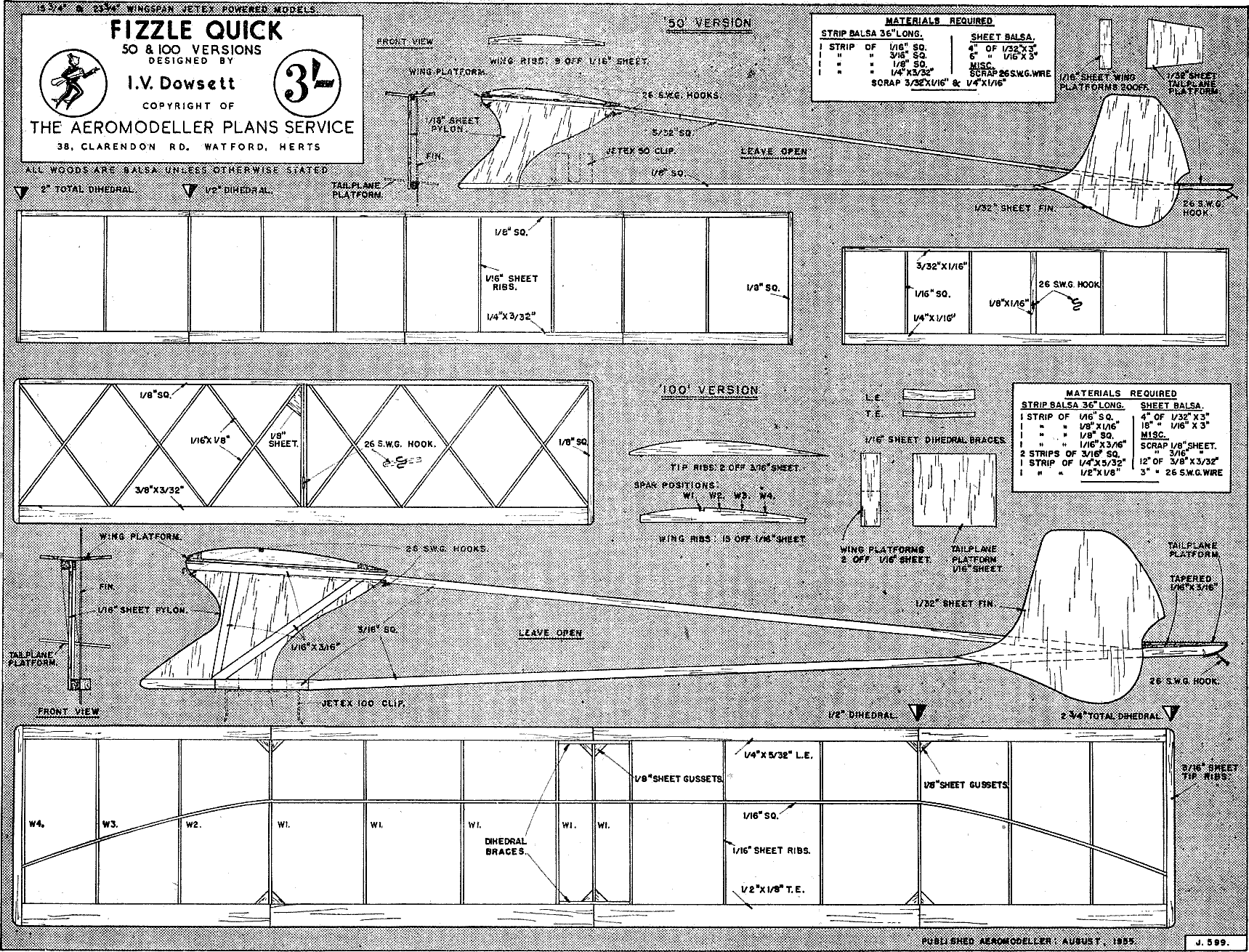|
From Aeromodeller, Aug. 1955 Ian Dowsett's high performance contest design for JETEX See dimensioned construction plan at end of article Fizzle Quick by Ian Dowsett Two for the price of one in this plan for the simplest of Jetex '50' or '100' models with unique open frame fuselage structure. AT THE 1954 All-Britain Rally we were endeavouring to report the annual I.C.I. Challenge Trophy for Jetex models and had the camera set at a high shutter speed to catch Ian Dowsett launching his unusual entry. Off went the jet - and our shutter, but we regret to say that we did not stop the model. Now this may sound a tall story when we can arrest the flight of other fast models as they are launched, but the fact remains that "Fizzle-Quick" has a lightning acceleration which has to be seen to be believed. The answer lies in its extreme light weight, minimum construction for maximum power, and the complete reduction of fuselage wetted area to a bare minimum, comprising a simple vertical "A" frame. The "100" version finished in third place at the "I.C.I. Trophy" and its best flight to date has been 5 minutes, 42 seconds, whilst an average through the season rests at 2 minutes, 15 seconds. Its smaller brother, the "50" has made 3 minutes, 37 seconds O.O.S. with a steady average of 1 minute, 45 seconds. Construction is the same for both types and, if built exactly to plan, either version should present you with contest performance from the very first flight onwards. Begin by laying the main longerons on the plan and joining them with the pylon construction. In the case of the "100" version there are two 1/16 x 3/16 strengtheners and, at the rear end, the sheet fin serves to make the longeron join more solid. Refer to the head-on view of the fuselage you are building so that you can see exactly how the pylon sheet is expected to fit on to the longerons. When lifted from the plan, the wing and tail platforms are cemented in place, noting in the head-on cross-section views that the tailplane platform is inclined so that the right-hand tail tip is much higher than the left. This provides the turn trim for the glide. Add the small wire hooks for the elastic bands and the unit clips. The wing and tail are as simple as one could desire with a flat-bottomed wing section and curved spar in the tips of the "100" version to help prevent warps. Both tailplane sections are flat. Flying. Designed to save weight, neither version will require nose weight if built according to plan The unit is set at straight thrust and slight right rudder may be required to assist the tilted tailplane in obtaining the right hand spiral climbing right-hand glide. A tip-up tailplane dethermaliser is advised and the rear portion of the wing acts as a limit-stop. The tailplane is simply retained in each place with an elastic band from the tail hook forwards and over the under-fin, and a fuse-loaded band passing backwards to the hook at the bottom of the fuselage. Be sparing with the dope and use lightweight tissue with a bright colour scheme for visibility and you will soon be enjoying some impressive flights at very little expense. Did we hear someone say "what happens if the longerons break?" Well, they have not broken as yet and if they so happen to go - then replacement will only be a matter of a copper or two. |
